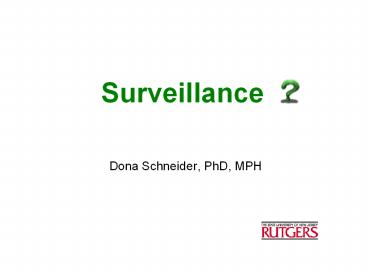Surveillance - PowerPoint PPT Presentation
Title:
Surveillance
Description:
Ebola haemorrhagic fever. Hepatitis. Influenza. Lassa fever. Marburg haemorrhagic fever ... Example: EBOLA VIRUS. Sentinel Surveillance. Monitors. Sites ... – PowerPoint PPT presentation
Number of Views:1206
Avg rating:3.0/5.0
Title: Surveillance
1
Surveillance
- Dona Schneider, PhD, MPH
2
- Surveillance is the ongoing, systematic
collection, analysis, and interpretation of
health data essential to the planning,
implementation, and evaluation of public health
practice, closely integrated with the timely
feedback of these data to those who need to
know. Centers for Disease Control
3
Surveillance can
- Estimate the magnitude of a problem
- Determine geographic distribution of illness
- Detect epidemics/outbreaks
- Generate hypotheses, stimulate research
- Evaluate whether control measures work
- Monitor changes in infectious agents
- Detect changes in health practices
4
Examples Morbidity and Mortality Weekly
Report http//www.cdc.gov/mmwr/ SEER Cancer
Registry http//seer.cancer.gov/ US Vital
Statistics http//wonder.cdc.gov/welcome.html
5
National Notifiable Diseases Surveillance System
(NNDSS) produces the data in the MMWR
- The reportable diseases list is revised
periodically by the Council of State and
Territorial Epidemiologists (CSTE) and the
Centers for Disease control (CDC) - States report their cases to the CDC
- Internationally quarantinable diseases (i.e.,
cholera, plague and yellow fever) must be
reported to the World Health Organization (WHO)
6
The Epidemic and Pandemic Alert and Response
(EPR) Program at the WHO Monitors
- Anthrax
- Avian influenza
- Crimean-Congo haemorrhagic fever (CCHF)
- Dengue/dengue haemorrhagic fever
- Ebola haemorrhagic fever
- Hepatitis
- Influenza
- Lassa fever
- Marburg haemorrhagic fever
- Meningococcal disease
- Plague
- Rift Valley fever
- Severe Acute Respiratory Syndrome (SARS)
- Smallpox
- Tularaemia
- Yellow fever
7
Surveillance for communicable diseases is
important
- The world population is highly mobile
- International travel and troop movements increase
the risk of communicable disease transmission - Forced migration for war and famine, and
voluntary immigration increase communicable
disease risk
8
Types of Surveillance
- Passive
- Inexpensive, provider-initiated
- Good for monitoring large numbers of typical
health events - Under-reporting is a problem
- Active
- More expensive, Health Department-initiated
- Good for detecting small numbers of unusual
health events - Enhanced
- Rapid reporting and communication between
surveillance agencies and stakeholders - Best for detecting outbreaks and potentially
severe public health problems
9
Syndromic surveillance
- Allows us to identify groups of signs and
symptoms that precede diagnosis and signal a
sufficient probability of a case or an outbreak
that warrants a further public health response - Example EBOLA VIRUS
10
Sentinel Surveillance
- Monitors
- Sites volcanos
- Events 9/11
- Providers ERs
- Vectors/animals
- Rabies
- West Nile
11
SENTINEL EVENT Nov 12, 2001 - 917 am Flight AA
587 Crashes in Rockaways 7-Zip Surveillance
showed 27 Obs / 10 Exp Resp Emergencies
plt0.001 31 Obs / 16 Exp Hospital Events
plt0.05
12
(No Transcript)
13
Investigation
- Chart review in one hospital (9 cases)
- Smoke Inhalation (1 case)
- Atypical Chest Pain / Anxious (2 cases)
- Shortness of Breath - Psychiatric (1 case)
- Asthma Exacerbation (3 cases)
- URI/LRI (2 cases)
- Checked same-day logs at 2 hospitals
- Increase not sustained
14
Cipro and Doxycycline Prescriptions
15
Blood Lead Measurements 1975-1981
110
18
Predicted blood lead
100
Lead used in gasoline (thousands of tons)
16
90
Mean blood lead levels ? g/dl
80
Gasoline lead
14
70
Observed blood lead
12
60
50
10
40
30
8
1975
1976
1977
1978
1979
1980
1981
Year
Source Pirkle et al JAMA 272284-91, 1994
16
Reported Salmonella Isolates, United States,
1976-2001
Data from Public Health Laboratory Information
System (PHLIS).
Source CDC. Summary of notifiable diseases.
2001.
17
(No Transcript)
18
Recent Occupational Monitoring Efforts for
Sentinel Events Include
- Biodetection Systems (BDS) in NJ post offices to
detect anthrax and soon, ricin - Biowatch, an air monitoring system in New York
City and 30 other cities
19
Free Resources
- World Health Organization
- DISMOD Software
- http//www.who.int/healthinfo/boddismod/en/
- Centers for Disease Control
- Epi Info and Epi Map
- http//www.cdc.gov/epiinfo/
20
- Good surveillance does not necessarily ensure the
making of right decisions, but it reduces the
chances of wrong ones.
Alexander D. Langmuir NEJM 1963268182-191































